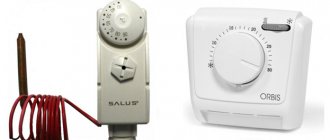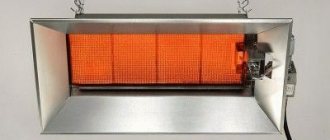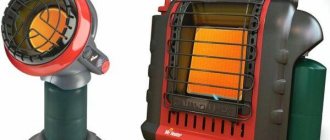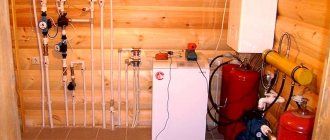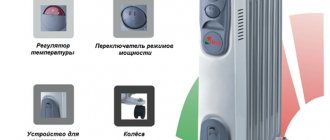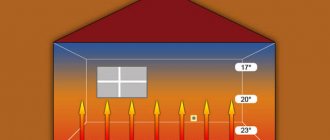Comfortable housing in a country house with optimal temperature conditions is the dream of any owner. Infrared heaters can provide warmth and provide a favorable microclimate at any time of the year both in your country house and at the dacha, and if you spend a little more and choose a model with a thermostat, you will get maximum comfort and efficiency. Let's look at their main technical characteristics and installation principle in this article.
IR lamp heater
The problem of heating a house is perhaps one of the most pressing for owners of country houses. It’s one thing if you need to provide heating at your dacha all year round. In this case, the best option would be to install a boiler, stove and radiators. It’s another matter if the dacha is a place of periodic pilgrimage for the owners. In this case, installing an expensive boiler, installing a chimney, wiring heating circuits and other complications are of no use to the owners.
If the cottage is intended mainly for the summer stay of the owners, and in winter its owners only occasionally visit there, installing an infrared heater will be a very practical solution.
Infrared heater in the living room
Operating principle of an infrared heater
To understand the distinctive operating principle of infrared heaters, you should recall the operating diagram of a classic-type heating system.
Comparison with classic heating circuit
In the first case, the room is heated due to heat transfer from the device itself. When heated, heat emanates from the walls, which warms up the room. The principle is simple, but not always effective, since it is very limited by the scale of the heating device itself.
The second heating option operates on the principle of convection.
Convection heater type
This method is directly related to the above-mentioned principle of heat exchange, only here there is forced circulation of warm air flows. The devices are usually equipped with special fans that create convection currents. Despite the greater efficiency of this method compared to a standard heat exchanger, it also has disadvantages.
Heating is often uneven. And such devices do not add comfort. Excessive noise, dust transfer, drafts - all this does little to create a homely atmosphere of comfort.
Ceiling type infrared heater
And now we come to the most important thing - the principle of operation of an infrared heater, which works according to a completely different scheme.
Operating principle of the IR heater
Here, heating of the room occurs due to the propagation of electromagnetic waves located in a given range: between the red edge of the visible light spectrum (wavelength is 0.74 microns) and the region of microwave radio emission (from 1000 to 2000 microns).
This operating principle is taken from nature itself. This is how our planet extracts heat from the flow of solar energy, which is necessary for all living things. The atmosphere does not become an obstacle to these invisible waves. Therefore, upon reaching the Earth, they cause heating of all opaque (from the point of view of wave physics) objects. And they, in turn, then give off heat to the air.
If in the classical scheme of operation of heaters thermal radiation is created, then in IR devices heating occurs due to electromagnetic waves. Devices operating according to the thermal energy release scheme cannot maintain a comfortable microclimate in the room, especially if its area exceeds 15 square meters.
High IR efficiency compared to standard heating system
An IR heater works on a different principle. Invisible red arrows (infrared rays) emanate from it in a certain sector, which do not heat the air themselves, but only give off thermal energy to all opaque objects: walls, curtains, furniture, etc. And then the basic principle of heat exchange in the room comes into play.
Selecting the optimal equipment power
The choice of convector power is made according to a very simple formula: to heat 1 m2 of room you need to spend 100 W of power. The resulting power must be increased one and a half to two times with ceiling heights over 2.5 meters . If the convector is used as an additional heating source, the power is reduced by 1.5 times.
| Device power, kW | Room area, m2 |
| 1000 | 10 |
| 1200 | 12 |
| 1500 | 15 |
| 2000 | 20 |
| 2500 | 25 |
Economic feasibility of purchasing a convector powered by electricity
- for heating a country house where there is no possibility of using gas networks;
- in apartments as the main or additional type of heating;
- shopping pavilions and tents where there is no other way to warm up during the cold season.
As practice shows, heating one square meter using an electric convector costs about 7 - 10 dollars per year. Thanks to the ability to adjust the temperature, you can save up to 40-80% of electrical energy, depending on the degree of use of your living space.
Design of infrared devices
Heating scheme for a country room using an IR heater
The design of the IR heater has the following elements:
- reflector;
- heater;
- emitter;
- frame;
- insulator.
When choosing a model of a device for a summer residence, much attention should be paid to such an element as the heater. Excellent performance in terms of reliability and durability is demonstrated by devices made of stainless steel with an anode coating.
Reflector (rear view)
For normal operation of the heater, the thickness of the reflector foil must be at least 130 microns. If it is too thin, it will significantly reduce the performance and service life of the device.
The insulator performs the function of retaining heat. Various materials can be used for this; basalt is considered one of the best.
How does an infrared heater with a thermostat work?
An infrared heater with a thermostat works on the same principle, the only difference being that it will maintain the set temperature. This allows you to create a comfortable indoor microclimate and save electricity. Having reached the set temperature, it automatically turns off and does not work until the room temperature drops below the set value.
Modern thermostat
If such a device does not have a thermostat, this greatly complicates the life of the owners. After all, you will have to turn the device on and off manually, personally monitoring the temperature in the room.
In terms of heating efficiency, there is no difference between conventional IR devices and those equipped with automatic thermostats. They heat objects equally well and create natural heat exchange in the room.
How to choose the right IR device for your garden
When deciding how to choose an infrared heater for your dacha, you must first:
- Decide on the installation location of the heating device (ceiling, wall, floor).
- Choose the appropriate power, which depends on the purpose (to warm up a certain area of the room for a comfortable stay or to heat the entire room as the main source of heating).
- Decide what type of thermostat you need (mechanical, electronic, with or without remote control, built-in or remote type).
- Decide on the presence of additional functions (protective sensors against overheating, emergency sensors when tipping over, etc.).
- It is also important to know how much money can be allocated for the purchase of an infrared heating device with a thermostat.
- You need to pay attention to manufacturers and their best and high-quality models (for more details, see the article rating the best infrared heaters).
When choosing a heating device for your dacha, you need to select its size so that it correlates with the size of the heated room.
Infrared heaters for summer cottages with a thermostat function are very often used for heating greenhouses and conservatories.
Advantages of infrared heaters with thermostat
- Saving electricity. Considering that the set temperature of the room is ensured by a thermostat, the total operating time per day is approximately 12-13 hours. Thus, electricity costs are almost halved.
- Ease of use. Needless to say, it is very convenient for home owners to set the temperature in the house once and calmly go about their daily affairs. The mechanism will turn off itself when the temperature rises to a critical point, and after the air in the room cools and the set temperature decreases, the device will automatically resume operation.
Thermostat is convenient, safe and economical
There is no need to constantly check the temperature or turn the IR heater on and off. And it will be quite safe for two people to leave the house for a day with such a device. Upon return, the atmosphere in the house will be warm and cozy.
- Safety. The automatic sensor itself maintains the temperature, turning off the device when it reaches a critical point.
- Quiet operation. Modern sensors operate absolutely silently, without “notifying” others when the device is turned on and off.
There are low-temperature, medium-temperature and high-temperature heaters.
- 300-1200 degrees Celsius – high temperature;
- 60-500 degrees Celsius – medium temperature;
- up to 60 degrees Celsius – low temperature.
Advantages and disadvantages of infrared devices
Infrared heaters with a thermostat for summer cottages are simply invaluable due to:
- Fast heating of any premises.
- Comfortable heating of air layers, with warm air distributed below the floor, and cold air accumulated near the ceiling.
- Oxygen is not burned and natural air humidity is maintained.
- Quiet operation.
- Stylish design.
- Easy assembly and installation.
Among the disadvantages, one can note the individual negative allergic effect of the device; in this case, you just need to avoid being exposed to the direct IR rays of the device and take care of your eyes.
You need to think in advance about the installation location of the device so that there is no direct effect of the rays on a person (it is not recommended to install them directly above the bed).
When purchasing an infrared heater for a summer residence, it is best to choose models with a thermostat. In this case, by setting the time for automatic switching on and off of the device, you can arrive in a heated, warm room. The main thing is to make sure that all overheating or emergency tip-over sensors are present and functioning properly.
